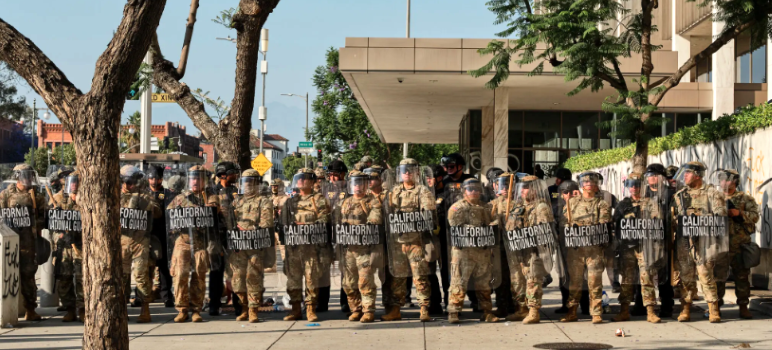A federal appeals court on Thursday cleared the way for President Trump to keep using the National Guard to respond to immigration protests in Los Angeles, declaring that a judge in San Francisco erred last week when he ordered Trump to return control of the troops to Gov. Gavin Newsom of California.
In a unanimous, 38-page ruling, a three-judge panel of the U.S. Court of Appeals for the Ninth Circuit held that the conditions in Los Angeles were sufficient for Trump to decide that he needed to take federal control of California’s National Guard and deploy it to ensure that federal immigration laws would be enforced.
The panel — made up of two appointees of Trump and one of former President Joseph R. Biden Jr. — rejected a lower-court judge’s conclusion that the protests were so unruly that they could trigger a rarely-used law that Trump invoked when he claimed the power to federalize the National Guard over Newsom’s objections.
“Affording appropriate deference to the President’s determination, we conclude that he likely acted within his authority in federalizing the National Guard,” the court wrote, in an unsigned opinion on behalf of the entire panel.
The ruling was not a surprise. During a 65-minute hearing on Tuesday, the panel’s questions and statements had telegraphed that all three judges — Mark J. Bennett, Eric D. Miller and Jennifer Sung — were inclined to let Trump keep controlling the Guard for now, while litigation continues to play out over California’s challenge to his move.
The state could choose to ask the full appeals court to rehear the matter, or it could directly ask the Supreme Court to intervene. But the state might also just move on from the current part of the dispute, since the ruling on Thursday pertains to a short-lived temporary restraining order that will soon be obsolete anyway.
Either way, litigation in the case is set to return on Friday to the San Francisco courtroom of the Federal District Court judge, Charles Breyer, for a hearing. He is weighing whether to issue a more durable preliminary injunction restricting what Trump can do with some 4,000 National Guard troops or 700 active-duty Marines his administration has also deployed into the city.
Judge Breyer’s temporary restraining order concerned only the National Guard and whether it was lawful for Trump to mobilize them under federal control. At the hearing on Friday, he is also set to address a state request to limit troops under federal control to guarding federal buildings, and to bar them from accompanying Immigration and Customs Enforcement agents on the workplace raids that sparked the protests.
That request centers on a 19th-century law, the Posse Comitatus Act, that generally makes it illegal to use the military for domestic law enforcement. The Trump administration has argued that the troops are not themselves performing law enforcement tasks, but rather are protecting civilian agents who are trying to arrest undocumented migrants.
Pete Hegseth, the defense secretary, suggested that he might not obey a ruling from the lower court, telling senators on the Armed Services Committee on Wednesday that he doesn’t “believe district courts should be setting national security policy.”
Conditions in Los Angeles have calmed significantly over the past week, and Mayor Karen Bass of Los Angeles announced on Tuesday that she was ending the downtown curfew, a week after it had first been imposed. She said local law enforcement efforts have been “largely successful” at reimposing order.
California officials have said from the beginning that local and state police could handle the protesters, and that Trump’s decision to send in federal troops only inflamed matters. But speaking with reporters outside the White House on Wednesday, Trump said he felt empowered to send troops anywhere violent protests erupt.
“We did a great job. We quelled that thing,” the president said of the demonstrations in Los Angeles. “And the fact that we are even there thinking about going in, they won’t bother with it anymore. They’ll go someplace else. But we’ll be there, too. We’ll be wherever they go.”
Charlie Savage and Laurel Rosenhall are reporters with The New York Times. Copyright 2025, The New York Times.


So much for Newsom’s folly.
2,000 more National Guards are a comin’.
Judge Breyer should hang-up his robes, right next to his brother’s.
David S. Wall
Unanimous panel of appellate judges.
How much of our taxpayer money has Gavin Newsom wasted on frivolous litigation against the federal government in a vain effort to burnish his image for a presidential run?
Turns out the President is indeed Commander in Chief. Not Judge Breyer. A reminder that San Francisco federal trial court judges are not kings.